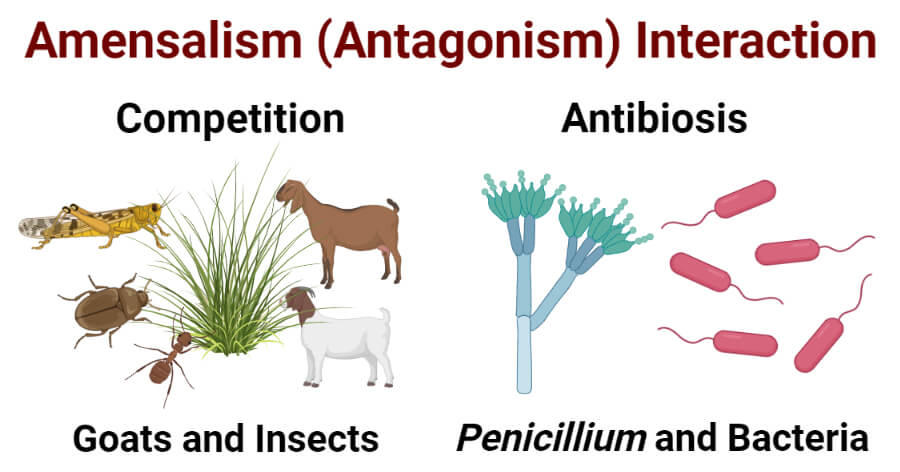Amensalism is a type of negative ecological interaction where one of the species is harmed or destroyed while the other either benefits or remains unaffected.
- Amensalism is usually considered a relationship that exists between organisms of two different species, but cases of such interactions can be observed even within the same species.
- Amensalism is one of the modes of evolution as the process of natural selection favors organisms that can effectively collect nutrients and energy for survival.
- Even though antagonism is often used as a synonym for amensalism, in antagonistic interactions, one of the species clearly benefits at the expense of the other.
- Amensalism is also referred to as asymmetrical competitive interaction as the interaction might not produce any benefits to either of the species.
- In most of the amensalism interactions in nature, the species causing the harm usually produce chemicals or other products that negatively impact the other species involved. The production of such products doesn’t occur as a response to the interaction but as the normal working of the species.
- Antagonistic interactions, in turn, involve defensive strategies in the form of chemical and physical deterrents either to protect themselves or to extract nutrients from the environment.

Types of Amensalism
Amensalism can be divided into two distinct types depending on the species involved and the effect of the interaction.
Interesting Science Videos
1. Competition
- Competition is a type of negative interaction where the larger or stronger species deprives the small species from food or living species.
- The species involved in such interactions share a common niche in the ecosystem. This results in the scarcity of nutrients as well as living spaces for the weaker species.
- The larger species, however, remains unaffected by the interaction, and the interaction occurs as a result of sharing a common ecological niche.
- Competition can occur between the organisms of the same species where both organisms tend to compete with each other for survival.
Example of Competition
1. Goat and insects
- Herbivores like goats share the same ecological niche as insects like grasshoppers. This results in competition between the two species for food resources.
- The goat feeds on the same type of shrubs or grass and insects. This results in a scarcity of food resources for the insects.
- The goat is unharmed by the interaction as the absence of the interaction doesn’t affect it, but the insects get deprived of a significant amount of food resources.
- This is a form of competition where the stronger species negatively impact the growth of weaker species present in the same ecological niche.
2. Larger and smaller fishes
- In aquatic habitats, smaller fishes compete with larger fishes for food resources. Both the type of fish feed on phytoplankton and zooplankton found in the water.
- The larger fishes can find and feed on these resources easily, which makes the resources scarce for the smaller fishes.
- This is a type of interspecies competition where the smaller fishes are negatively affected by the interaction with larger fishes.
2. Antibiosis
- Antibiosis is an important type of amensalism where one of the species is killed by a chemical secretion while the other remains unaffected.
- The term antibiosis is derived from the French term ‘antibiose’ to define the antagonistic relationship between species colonizing similar ecological niches.
- One of the species involved in the species produces antibiotics as a form of defensive mechanism against possible predators. Some species might even produce toxins.
- The antibiotics thus can be negative for some of the species sharing the same habitat as the antibiotic producer.
- Antibiosis is thus considered a case of interference competition where one of the species inhibits the development of the other and gains access to more food and resources.
- This type of interaction is common in prokaryotes and eukaryotes and has been studied in its potential to protect humans from various microbial diseases.
Examples of Antibiosis
1. Penicillium and bacteria
- A classic example of antibiosis can be observed between the fungal species Penicillium and different bacterial species.
- The fungal species secretes penicillin as a secondary metabolite during growth. Penicillin has an antagonistic effect against various bacterial species.
- This interaction was the basis of the discovery of penicillin as the first antibiotic. In nature, Penicillium produces the antibiotic as a form of secondary metabolite, but the bacteria sharing a common niche with the mold get negatively affected.
- The interaction has now been used for the production of various antibiotics as well as toxins with medical importance.
2. Black walnut and herbaceous plants
- Black walnut (Juglans nigra) produces a substance called juglone that has an antagonistic effect on various herbaceous plants present in the root zone of the plant.
- The walnut plant produces the chemical as a form of defensive mechanism against various plant pathogens.
- The herbaceous plants occurring in the root zone are affected by the secretion, whereas the walnut plant remains unaffected.
References and Sources
- Moënne-Loccoz, Yvan et al. “Microorganisms and Biotic Interactions.” Environmental Microbiology: Fundamentals and Applications: Microbial Ecology 395–444. 29 Apr. 2014, doi:10.1007/978-94-017-9118-2_11
- https://www.britannica.com/science/amensalism
- https://guide2agriculture.com/amensalism/
- 1% – https://www.sciencedirect.com/topics/biochemistry-genetics-and-molecular-biology/symbiotic-interaction
- 1% – https://www.reference.com/science/five-steps-natural-selection-98f82252c500a28c
- 1% – https://www.britannica.com/science/antagonism-ecology
- 1% – https://www.biologydiscussion.com/microbiology-2/microbial-associations/symbiotic-relationship-between-organisms-microbiology/55681
- 1% – https://sciencestruck.com/examples-of-symbiotic-relationships-in-deciduous-forest
- 1% – https://onlinelibrary.wiley.com/doi/full/10.1002/ece3.6990
- 1% – https://malaysia.answers.yahoo.com/question/index?qid=20101121063345AAaBPSc
- <1% – https://quizlet.com/8987136/apes-chapter-8-flash-cards/
- <1% – https://quizlet.com/185100161/chapter-6-apes-flash-cards/
- <1% – https://en.wikipedia.org/wiki/Intraspecific_competition
- <1% – https://en.wikipedia.org/wiki/Competing_species
